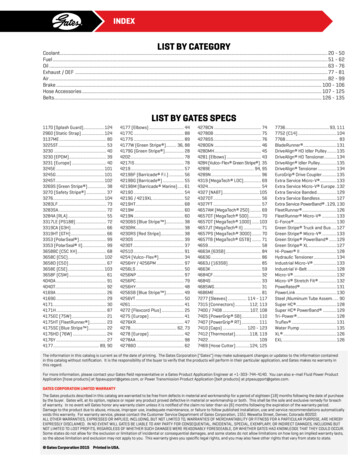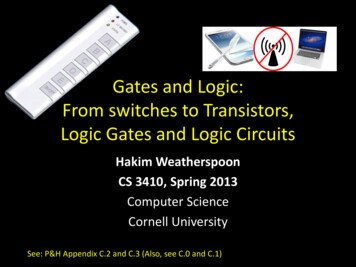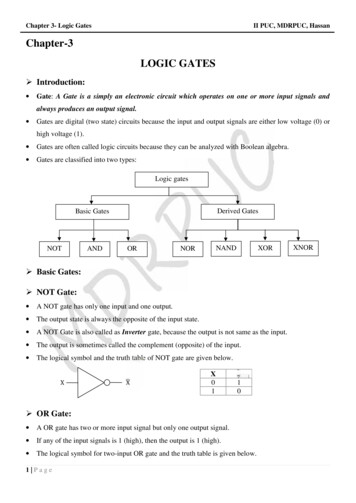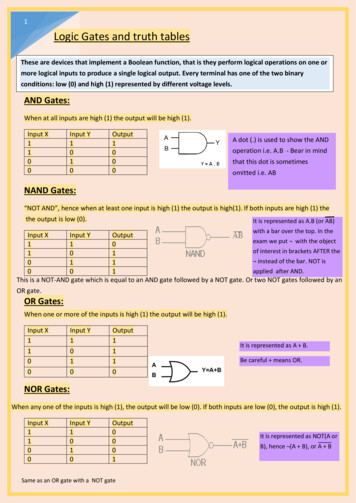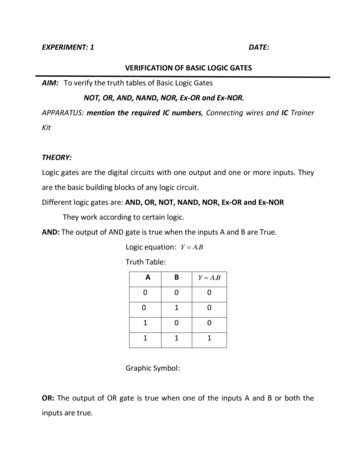
Transcription
Sacred Texts Egypt EHH Index Index NextThe Book of Gateswith the Short Form of the Book Am-TuatLondon; Kegan, Paul, Trench, Trübner & Co.[1905]Scanned at Sacred-texts.com, May 2003. J.B. Hare, Redactor. This text is in the public domain. These files may be used for anynon-commercial purpose, provided this notice of attribution is left intact.Next: Note
Sacred Texts Egypt EHH IndexVol. I Vol. II Vol. IIIThe Book of Gatesby E. A. Wallis Budge[1905](original title) The short form of the Book of am-tuat and the Book of GatesThe Book of Gates is an Ancient Egyptian cosmological treatise describing the architecture andinhabitants of the Tuat, the underworld which the boat of the Sun God, Ra, traverses during the nighthours. This is the second volume of the three volume Budge series which deals with the books of theUnderworld, the Egyptian Heaven and Hell . It also includes a short summary of the Book of Am-Tuat,the longer version of which comprises the first volume.Title PageNoteContentsThe Short Form of the Book of Am-TuatThe First HourThe Second HourThe Third HourThe Fourth HourThe Fifth HourThe Sixth HourThe Seventh HourThe Eighth HourThe Ninth HourThe Tenth HourThe Eleventh HourThe Twelfth HourThe Book of GatesChapter I. The Alabaster Sarcophagus of Seti I.Chapter II. The Ante-Chamber of the TuatChapter III. The Gate Of Saa-Set: The Second Division of the Tuat.Chapter IV. The Gate Of Aqebi. The Third Division of the Tuat.Chapter V. The Gate Of Tchetbi. The Fourth Division of the TuatChapter VI. The Gate Of Teka-Hra. The Fifth Division of the TuatChapter VII. The Judgment Hall of Osiris. The Sixth Division of the Tuat.Chapter VIII. The Gate Of Set-em-maat-f. The Sixth Division Of The Tuat--continued.Chapter IX. The Gate Of Akha-En-Maat. The Seventh Division of the Tuat.Chapter X. The Gate of Set-hra. The Eighth Division of the Tuat.Chapter XI. The Gate Of Ab-ta. The Ninth Division of the Tuat.
Chapter XII. The Gate of Sethu. The Tenth Division of the Tuat.Chapter XIII. The Gate Of Am-netu-f. The Eleventh Division of the Tuat.Chapter XIV. The Gate of Sebi and Reri. The Twelfth Division of the Tuat
Sacred Texts Egypt EHH Index Index Previous NextNOTETHIS volume is the second of a series of three volumes which treat of the Egyptian Heaven and Hell. Itcontains the complete hieroglyphic text of the Summary, or short form of the BOOK AM-TUAT, and thecomplete hieroglyphic text of the BOOK OF GATES, with translations and reproductions of all theillustrations. A series of Chapters dealing with the origin and contents of Books of the Other World, withprefatory remarks, and a full index to the whole work, will be found in the third volume.Next: Contents
Sacred Texts Egypt EHH Index Index Previous Nextp. 1THE SHORT FORMOF THEBOOK OF AM-TUATTHE SUMMARY OF THE BOOK OF WHAT IS IN THE UNDERWORLD.THE BEGINNING OF THE HORN OF AMENTET, [WHICH IS] THE UTTERMOST POINT OF THEDEEPEST DARKNESS.THE FIRST HOUR.THIS god entereth into the earth through the Hall of the horizon of Amentet. There are one hundred andtwenty ATRU to journey over in this Hall before a man arriveth at the gods of the Tuat.The name of the first Field of the Tuat is NET-RA. He (i.e., Ra) allotteth fields to the gods who are in[his] following, and he beginneth to send forth words to and to work out the plans of the divine beings ofthe Tuat in respect of this Field.Whosoever shall have these made (i.e., copied)p. 2according to the similitude which is in Ament of the Tuat, [and] whosoever shall have knowledge ofthese similitudes, [which are] the copies of this great god himself, they shall act as magical protectors forhim upon earth regularly and unfailingly, and they shall act as magical protectors for him in the GreatTuat.USHEMET-HATU-KHEFTI-RA is the name of the [first] hour of the night which guideth this great godthrough this Hall.Next: The Second Hour
Sacred Texts Egypt EHH Index Index Previous Nextp. 4THE SECOND HOUR.This great god afterwards taketh up his position in UR-NEST, which is three hundred and nine ATRU inlength, and one hundred and twenty ATRU in width.The name of the gods who are in this Field is, BAIU-TUATI. Whosoever knoweth their names shall havehis existence with them, and unto him shall this great god allot fields in the place wherein they are in theFIELD OF URNES. He shall stand up with the Gods who Stand Up (AHAU), he shall travel on in thefollowingp. 5of this great god, he shall enter into the earth, he shall force a way through the Tuat, he shall cleave apassage through the tresses of the gods with flowing hair (HENKSU), he shall travel on by the EATEROF THE ASS (AM-AA) after the emptying of the lands, he shall eat bread-cakes in the Boat of the Earth,and there shall be given unto him the fore-part of TATUBA.Whosoever shall have made in writing (or, in drawing) similitudes of the BAIU-TUATI (i.e., the Souls ofthe Tuat) in the forms in which they are in Ament of the Tuat-now the beginning of such representationsshould be from Amentet,--and whosoever shall make offerings unto them upon earth in their names,[these things I say] shall act as magical protectors to that person upon earth, regularly and unfailingly.And whosoever shall know the words which the gods of the Tuat speak to this god, and the words whichare said by him to them when he is approaching the gods of the Tuat, [these words I say] shall act asmagical protectors to him that knoweth them upon earth, regularly and unfailingly.SHESAT-MAKET-NEB-S is the name of the hour of the night which guideth this great god through thisField.Next: The Third Hour
Sacred Texts Egypt EHH Index Index Previous Nextp. 8THE THIRD HOUR.This great god afterwards taketh up his position in the Fields of the PERU-gods (i.e., the Fighters), andp. 9this great god paddleth his way over the STREAM OF OSIRIS (NET-ASAR) in sailing up this Field,which is three hundred and nine ATRU long, and one hundred and twenty ATRU wide. This great goduttereth words to those who are in the following of Osiris to this City, and he allotteth unto them estateswhich are situated in this Field.BAIU-SHETAIU (i.e., Hidden Souls) is the name of the gods who are in this Field, and whosoeverknoweth their names upon earth shall be able to approach to the place where Osiris is, and there shall begiven unto him water for his Field.NET-NEB-UA-KHEPER-AUATU is the name of this Field. Whosoever shall know these hiddensimilitudes of the Hidden Souls in the correct forms wherein they are depicted in Ament of theTuat--now the beginning of such representations should be from Amentet--[these figures I say] shall actas magical protectors to that man upon earth, [and] in Neter-khert, regularly and unfailingly.Whosoever knoweth these, when he is making his journey past them shall escape from their roarings,and he shall not fall down into their furnaces (or, pits).Whosoever knoweth this, when 'he is keeping ward over [his] seat (or, place), his bread-cake shall bewith Ra; and whosoever knoweth this, being soul [and] spirit, shall have the mastery over his legs, andshall never enter into the place of destruction, but he shallp. 10come forth with his attributes (or, forms), and shall snuff the air for his hour.THENTENT-BAIU is the name of the hour of the night which guideth this great god through this Field.Next: The Fourth Hour
Sacred Texts Egypt EHH Index Index Previous Nextp. 13THE FOURTH HOUR.The majesty of this great god, having been towed along, afterwards taketh up his position in the secretCircle of AMENTET, and he performeth the affairs of the gods of the Tuat who are therein by means ofhis voice, but he seeth them not.ANKH-KHEPERU is the name of the gate of this Circle.AMENT-SETHAU is the name of this Circle.Whosoever knoweth this representation of the hidden roads of RE-STATET, and the holy paths of theAMMEHET, and the secret doors which are in the Land Of SEKER, the god who is upon his sand, shallbe in the condition of him that eateth the bread-cakes which are [made] for the mouth of the LIVINGgods in the Temple of Tem.Whosoever knoweth this shall be in the condition of him that is maat on the ways, and he shall journeyp. 14over the roads of RE-SETHAU, and he shall see the representations of the AMMEHET.URT-EM-SEKHEMU-SET is the name of the hour of the night which guideth this great god.Next: The Fifth Hour
Sacred Texts Egypt EHH Index Index Previous Nextp. 16THE FIFTH HOUR.This great god is towed along over the ways of Maat of the Tuat through the upper half of this secretCircle of the god SEKER, who is upon his sand, and he neither looketh upon nor gazeth at the secretfigure of the earth which containeth the flesh of this god. The gods who are in [the train of] this god hearthe words of Ra, who crieth unto them from where this god is.AHA-NETERU is the name of the door [of this City].AMENT is the name of the Circle of this god, [and in it are] the secret path of Amentet, and the doors ofthe hidden palace, and the holy place of the LAND OF SEKER [with his] flesh, and [his] members, [andhis] body, in the divine form which they had at first.BAIU-AMU-TUAT is the name of the gods who are in [this] Circle. Their forms (aru) who are in theirhour,p. 17and their secret shapes (kheperu ) neither know, nor look upon, nor see this image (or, similitude) ofSEKER (or, the hawk) himself.Whosoever shall make these representations according to the image which is in writing in the hiddenplaces of the Tuat, at the south of the Hidden Palace, and whosoever shall know them shall be at peace,and his soul shall unite itself to the offerings of SEKER, and the goddess KHEMIT shall not hack hisbody in pieces, and he shall go on his way towards her in peace. Whosoever shall make offerings tothese gods upon earth--[these offerings, I say, shall act as magical protectors to that man upon earth, andin NETER-KHERT, regularly and unfailingly].SEM-HER-AB-UAA-S is the name of the hour of the night which guideth this great god through thisField.Next: The Sixth Hour
Sacred Texts Egypt EHH Index Index Previous Nextp. 20THE SIXTH HOUR.The majesty of this great god taketh up his position in the stream of NEBT-MU-TUATIU (i.e., the Lordof the waters of the gods of the Tuat), and he sendeth forth words to the gods who are therein, and hecommandeth that they have the mastery over their divine offerings in this City. He maketh his waythrough this Field, being provided with his Boat, and he setteth apart by his words the estates which are[to produce] their offerings in this City, and he giveth to them water for their lakes, and he travelleththrough the Tuat every day.SEPT-METU is the name of the door of this City.p. 21The secret roads of Amentet, and the manner wherein this great god is being rowed along over the watertherein in his boat to perform the plans (or, affairs) of the gods of the Tuat, the gathering together [ofthem] by their names, the manifestations of their shapes (or, forms), and [their] secret hours, such are thethings of which the secret representation of the Tuat is not known to men and women.Whosoever shall make [a copy of] this image in writing, according to the representation of the samewhich is in the hidden things of the Tuat, at the south of the Hidden Palace, and whosoever shall knowthem shall be in the condition of one who awardeth offerings in abundance in the Tuat, and he shall beunited to the offerings of the gods who are in the following of Osiris, and his Parents (or, kinsfolk) shallmake the offerings which are obligatory on the earth.The majesty of this great god sendeth forth words, and he giveth divine offerings to [the gods of] theTuat, and he standeth up by them; and they see him, and they have dominion over their Fields and overthe gifts made to them, and they effect their transformations by reason of the words which this great godhath spoken unto them.METCHET-NEBT-TUATIU is the name of this Field, which is the road of the Boat of Ra.MESPERIT-AR-MAAT is the name of the hour of the night which guideth this great god through thiscountry.Next: The Seventh Hour
Sacred Texts Egypt EHH Index Index Previous Nextp. 25THE SEVENTH HOUR.The majesty of this great god taketh up his position in the secret place of Osiris, and the majesty of thisgreat god sendeth forth words into this to the gods who dwell therein. This god maketh to himself otherforms for this hidden place in order to drive out of his path the serpent fiend APEP by means of thewords of power of Isis, and the words of power of SEMSU (?).RUTI-ASAR is the name of the gate of this City through which this god passeth.TEPHET-SHETA is the name of this City.p. 26This great god maketh his way over the road of Ament in the holy boat, and he passeth in it over thisroad which is without water, without being towed along. He maketh his way by means of the words ofpower of Isis, and by means of the words of power of SEMSU (?), and the utterances of this great godhimself [act as] magical protectors, and perform the slaughters of Apep in the Tuat, in this Circle, in hiswindings in the sky.Whosoever shall make [a copy of] these [pictures] according to the similitudes which are in writing at thenorthern side of the Hidden Palace in the Tuat, they shall act as magical protectors for him that makeththem in heaven and in earth. And whosoever knoweth them shall be a soul of souls with Ra. Andwhosoever shall make (i.e., recite) the words of power of Isis and the words of power of SEMSU, shallmake to be driven back the Apep of Ra in Amentet. Whosoever shall do [this] in the Hidden Palace ofthe Tuat, and whosoever shall do [this] upon earth, [the result is] the same. Whosoever knoweth thisshall be in the Boat of Ra, both in heaven and upon earth; but he that hath no knowledge of thisrepresentation shall not know how to drive back NEHA-HRA (i.e., Stinking-Face).Now the ridge of earth of NEHA-HRA in the Tuat is four hundred and fifty cubits in length, and hefilleth it with the undulations of his body. The regions which belong to him are made (i.e., kept) for him,and the great god doth not make his way over him when hep. 27maketh him to turn aside out of the way for him, from the secret place of Osiris, when this god makethhis way through this city in the form of the serpent MEHEN.Whosoever shall know this upon earth, the serpent NEHA-HRA shall not drink his water, and the soul ofhim that knoweth it shall not be evilly entreated by the gods who are in this Circle; and whosoeverknoweth it the crocodile AB-SHAU shall not devour his soul.KHESEF-HAI-HESEQ-NEHA-HRA is the name of the hour of the night which guideth this great godthrough this Circle.Next: The Eighth Hour
Sacred Texts Egypt EHH Index Index Previous Nextp. 30THE EIGHTH HOUR.When the majesty of this great god hath taken up his position in the secret Circles of those who are intheir sand, he sendeth forth words to them from out of his Boat, and the gods tow along him that is in theholy embrace (?) of the serpent MEHEN.AHA-AN-URT-F is the name of the gate of this City.TEBAT-NETERU-SET is the name of this City.As for the secret Circle of AMENTET, this great god maketh his way over it in his Boat, by means of thetowing of the gods who are in the Tuat.Whosoever shall make [a copy of] these things according to the similitude which is in writing on thenorth [wall] of the Hidden Palace in the Tuat, and whosoever shall know them by their names, shall be inthe condition of one who is fully provided with swathings on the earth, and he shall never be repulsed atthe secret gates, and he shall have abundant offerings in the great funeral hall regularly and unfailinglyfor millions of years.NEBT-USHA is the name of the hour of the night which guideth this great god.Next: The Ninth Hour
Sacred Texts Egypt EHH Index Index Previous Nextp. 32THE NINTH HOUR.When the majesty of this great god hath taken up his position in this Circle, he sendeth forth words fromhis Boat to the gods who dwell therein, and the sailors join the, Boat of this great god in this City.SAA-KEB is the name of the gate of this City through which this great god passeth to take up his positionon the stream which is in this City.BES-ARU is the name of this City, which is the secret Circle of AMENTET, wherein take up theirpositions in the Tuat this great god and his sailors.Whosoever maketh [a copy of] these things in their names according to the similitudes which are inwriting on the east [wall] of the Hidden Palace of the Tuat, and whosoever knoweth their names uponearth, and knoweth their habitations in Amentet, shall rest in his habitation in the Tuat, and he shall standup among the lords of the provisions of the gods, and his voice shall be maat before the tchatcha beingson the day of the reckoning of Pharaoh (literally, the thrice great house). And these things shall act asmagical protectors to him that knoweth them upon earth.MAK-NEB-S is the name of the hour of the night which guideth this great god in this Circle.Next: The Tenth Hour
Sacred Texts Egypt EHH Index Index Previous Nextp. 34THE TENTH HOUR.The majesty of this great god taketh up his position in this Circle, and he sendeth forth words to the godswho are in it.AA-KHEPERU-MES-ARU is the name of the gate of this City through which this great god passeth.METCH-QA-UTEBU is the name of this City. [This is] the secret Circle of Amentet whereto KHEPERAjoineth himself before Ra, and the gods, and the spirits, and the dead cry out from it over the secretrepresentations (or, images) Of AKERT.Whosoever shall make [a copy of] these [representations] according to the figures which are depicted onthe east [wall] of Ament, and whosoever knoweth them by their names shall journey round about in theTuat, and shall travel through it, and he shall not be driven back, and he shall flourish with Ra.TENTENIT-HESQ-KHAKABU is the name of the hour of the night which guideth this great god throughthe secret ways of this City.Next: The Eleventh Hour
Sacred Texts Egypt EHH Index Index Previous Nextp. 36THE ELEVENTH HOUR.The majesty of this great god taketh up his position in this Circle, and he sendeth forth words unto thegods who are therein.SEKHEN-TUATIU is the name of the gate of this City through which this great god passeth.RE-EN-QERERT-APT-KHAT is the name of this City. [This is] the secret Circle of the Tuat into whichthis great god passeth on his way, and [he] cometh forth at the eastern mountain of the sky, the eater ofeternity. The form thereof is in the presence of the serpent PETRA, which dwelleth in this City, and they(i.e., the gods) place themselves in the train of [Ra] when the birth of KHEPER upon earth is about totake place.Whosoever shall make [a copy] of these [representations] according to the figures which are depicted onthe east [wall] of the palace of Ament in the hidden [places] of the Tuat, and whosoever knoweth themshall be in the position of him that divideth his offering, and of him who is a spirit who is suitablyequipped [to travel] both in heaven and upon earth, regularly and unceasingly.SEBIT-NEB-UAA-KHESEF-SEBIU-EM-PERT-F is the name of the hour of the night which guideth thisgreat god in this Circle.Next: The Twelfth Hour
Sacred Texts Egypt EHH Index Index Previous Nextp. 38THE TWELFTH HOUR.The majesty of this great god taketh up his position in this Circle at the limits of the thick darkness, andthis great god is born under the form of KHEPERA in this Circle. The gods NU and AMMUI, and HEHand HEH[UT] are in this Circle at the birth of this great god, when he maketh his appearance from theTuat, and taketh up his place in the Matet Boat, and riseth from between the thighs of the goddess Nut.THENEN-NETERU is the name of the gate of this City.KHEPER-KEKUI-KHA-MESTI is the name of this City. [This is] the secret Circle of the Tuat, whereinthis great god is born, when he maketh his appearance in NU, and taketh up his place in the body ofNUT.Whosoever shall make [a copy] of these [representations] according to the figures which are depicted onthe east [wall] of the palace of Ament of the Tuat, they shall be magical protectors to him that knoweththem upon earth, both in heaven and on earth.At this point the light beginneth [to come], and it is the end of the thick darkness which Ra travelleththrough in Amentet, and of the secret matters which this great god performed therein. He who hath noknowledge of the whole (?) or part (?) of the secretp. 39representations of the Tuat, shall be condemned to destruction.Whosoever shall make [a copy] of these [representations] according to this copy of what is in the Amentof the Tuat, [which] cannot be looked at or seen, and whosoever shall know these secret images shall bein the condition of the spirit who is equipped [for journeying], and shall come forth [from] and shalldescend into the Tuat, and shall hold converse with the men and women who live [there] regularly andunfailingly, millions of times.Next: Chapter I. The Alabaster Sarcophagus of Seti I.
Sacred Texts Egypt EHH Index Index Previous Nextp. 43THE BOOK OF GATESCHAPTER I.THE ALABASTER SARCOPHAGUS OF SETI I.THE text of the "Book of Gates," printed in the following pages, is taken from the alabaster sarcophagusof king Seti I., B.C. 1370, which is preserved in the Museum of Sir John Soane, at 13, Lincoln's InnFields. This sarcophagus is, undoubtedly, one of the chief authorities for the text of that remarkablebook; but before any attempt is made to describe the arrangement of the scenes and the inscriptionswhich accompany them, it will be well to recall the principal facts connected with its discovery byGiovanni Battista Belzoni, who has fortunately placed them on record in his Narrative of the Operationsand recent discoveries within the pyramids, temples, tombs and Excavations in Egypt and Nubia ,London, 1820, p. 233 ff. In October, 1815, Belzoni began to excavate in the Biban-al-Muluk, i.e., theValley of the Tombs of the Kings, on the western bank of the Nile at Thebes, and in thep. 44bed of a watercourse he found a spot where the ground bore traces of having been "moved." On the 19thof the month his workmen made a way through the sand and fragments of stone which had been piled upthere, and entered the first corridor or passage of a magnificent tomb, which he soon discovered to havebeen made for one of the great kings of Egypt. A second corridor led him to a square chamber which,being thirty feet deep, formed a serious obstacle in the way of any unauthorized intruder, and served tocatch any rain-water which might make its way down the corridors from the entrance. Beyond thischamber are two halls, and from the first of these Belzoni passed through other corridors and rooms untilhe entered the vaulted chamber in which stood the sarcophagus. 1 The sarcophagus chamber is situatedat a distance of 320 feet from the entrance to the first corridor, and is 180 feet below the level of theground. Belzoni succeeded in bringing the sarcophagus from its chamber into the light of day withoutinjury, and in due course it arrived in England; the negotiations which he opened with the Trustees of theBritish Museum, to whom its purchase was first proposed, fell through, and he subsequently sold it to SirJohn Soane, it is said for the sum of 2000. An examination of the sarcophagus shows that both it and itscover were hollowed out of monolithic blocks of alabaster,p. 45and it is probable, as Mr. Sharpe says, 1 that these were quarried in the mountains near Alabastronpolis,i.e., the district which was known to the Egyptians by the name of Het-nub, and is situated near the ruinsknown in modern times by the name of Tell al-'Amarna. In the Yet-nub quarries large numbers ofinscriptions, written chiefly in the hieratic character, have been found, and from the interesting selectionfrom these published by Messrs. Blackden and Fraser, we learn that several kings of the Ancient andMiddle Empires carried on works in them, no doubt for the purpose of obtaining alabaster for funeralpurposes. The sarcophagus is 9 ft. 4 in. long, 3 ft. 8 in. wide, in the widest part, and 2 ft. 8 in. high at theshoulders, and 2 ft. 3 in. at the feet; the cover is 1 ft. 3 in. high. The thickness of the alabaster varies from21 to 4 inches. The skill of the mason who succeeded in hollowing the blocks without breaking, or evencracking them, is marvellous, and the remains of holes nearly one inch in diameter suggest that the drillwas as useful to him as the chisel and mallet in hollowing out the blocks. When the sarcophagus and itscover were finally shaped and polished, they were handed over to an artisan who was skilled in cutting
hieroglyphics and figures of the gods, &c., in stone, and both the insides and outsides were covered byhimp. 46with inscriptions and vignettes and mythological scones which illustrated them. Both inscriptions andscenes were then filled in with a kind of paint made from some preparation of copper, and the vividbluish green colour of this paint must have formed a striking contrast to the brilliant whiteness of thealabaster when fresh from the quarry. At the present time large numbers of characters and figures aredenuded of their colour, and those in which it still remains are much discoloured by London fog andsoot.The first to attempt to describe the contents of the texts and scenes on the sarcophagus of SETI I. was thelate Samuel Sharpe, who, with the late Joseph Bonomi, published "The Alabaster Sarcophagus ofOimenepthah I., King of Egypt," London, 1864, 4to; the former was responsible for the letterpress, andthe latter for the plates of scenes and texts. For some reason which it is not easy to understand, Mr.Sharpe decided that the hieroglyphic characters which formed the prenomen of the king for whom thesarcophagus was made were to be read "Oimenepthah," a result which he obtained by assigning thephonetic value of O to the hieroglyphic sign for Osiris, or, and. The prenomen is sometimes written, and is to be read either SETI-MEN-EN PTAH,or SETI-MEN-EN-PTAH. Mr. Sharpe did not, apparently, realize that both the signsandp. 47were to be read "Set," and he gave to the first the phonetic value of A and to the second the value of O;he next identified "Aimenepthah" or "Oimenepthah" with the Amenophath of Manetho, and theChomaepthah of Eratosthenes, saying, "hence arises the support to our reading his name (i.e., the king's)Oimenepthah." Passing over Mr. Sharpe's further remarks, which assert that the sarcophagus was made inthe year B.C. 1175 (!), we must consider briefly the arrangement of the texts and scenes upon the insidesand outsides of the sarcophagus and its covers. On the upper outside edge of the sarcophagus runs asingle line of hieroglyphics which contains speeches supposed to be made to the deceased by the fourchildren of Horus; this line is in two sections, each of which begins at the right hand side of the head,and ends at the left hand side of the foot. Below this line of hieroglyphics are five large scenes, each ofwhich is divided into three registers, and these are enclosed between two dotted bands which areintended to represent the borders of the "Valley of the Other World." On the inside of the sarcophagusare also five scenes, but there is no line of hieroglyphics running along the upper edge. On the bottom ofthe sarcophagus is a finely cut figure of the Goddess Nut, and round and about her are texts selectedfrom the Theban Recension of the Book of the Dead ; on the inside of the cover is a figure of the goddessNut, with arms outstretched. On the outside of thep. 48cover, in addition to the texts which record the names and titles of the deceased, are inscribed two largescenes, each of which is divided into three registers, like those inside and outside the sarcophagus.The line of text on the upper outside edge reads:-p. 50I. Speech of MESTHA: "I am Mestha, I am [thy] son, O Osiris, king, lord of the two lands, Men-Maat-Ra,whose word is maat, son of the Sun, Seti Mer-en-Ptah, whose word is maat, and I have come so that I
may be among those who protect thee. I make to flourish thy house, which shall be doubly established,by the command of Ptah, by the command of Ra himself."Speech of ANPU: "I am Anpu, who dwelleth in (or, with) the funeral chest." He saith, "Mother Isisdescendeth . . . . . . . . bandages for me, Osiris, king Men-Maat-Ra, whose word is maat, son of the Sun,Seti Mer-en-Ptah, whose word is maat, from him that worketh against me."Speech of TUAMATEF: "I am Tuamatef, I am thy son Horus, I love thee, and I have come to avengethee, Osiris, upon him that would work his wickednessp. 51upon thee, and I will set him under thy feet for ever, Osiris, king, lord of the two lands, Men-Maat-Ra,son of the Sun, [proceeding] from his body, loving him, lord of crowns (or, risings) Seti Mer-en-Ptah,whose word is maat, before the Great God."To be said: "Ra liveth, the Tortoise dieth! Strong are the members of . . . . . Osiris, king Men-Maat-Ra,whose word is maat, for Qebhsennuf guardeth them. Ra liveth, the Tortoise dieth! In a sound state is hewho is in the sarcophagus, in a sound state is he who is in the sarcophagus, that is to say, the son of theSun, Seti Mer-en-Ptah, whose word is maat."Speech of NUT: Nut, the great one of Seb, saith: "O Osiris, king, lord of the two lands, Men-Maat-Ra,whose word is maat, who loveth me, I give unto thee purity on the earth, and splendour (or, glory) in theheavens, and I give unto thee thy head for ever."II. Speech of NUT, who is over the HENNU BOAT: "This is my son, Osiris, king, Men-Maat-Ra, whoseword is maat. His father Shu loveth him, and his mother Nut loveth him, Osiris, son of Ra, SetiMer-en-Ptah, whose word is maat."Speech of HAPI: "I am Hapi. I have come that I might be among those who protect thee, I bind togetherfor thee thy head, [and thy members, smiting down for thee thine enemies beneath thee, and I givep. 52thee] thy head, O Osiris, king, Men-Maat-Ra
The Book of Gates by E. A. Wallis Budge [1905] (original title) The short form of the Book of am-tuat and the Book of Gates The Book of Gates is an Ancient Egyptian cosmological treatise describing the architecture and inhabitants of the Tuat, the underworld which the boat of the Sun God, Ra, traverses during the night hours.


